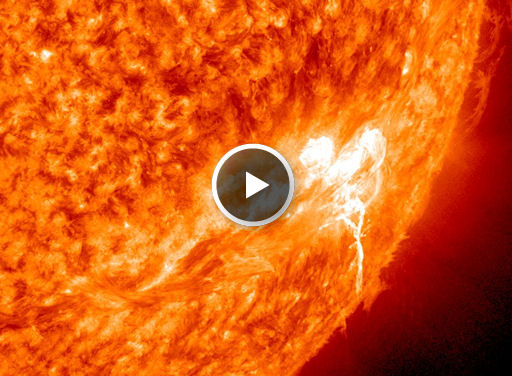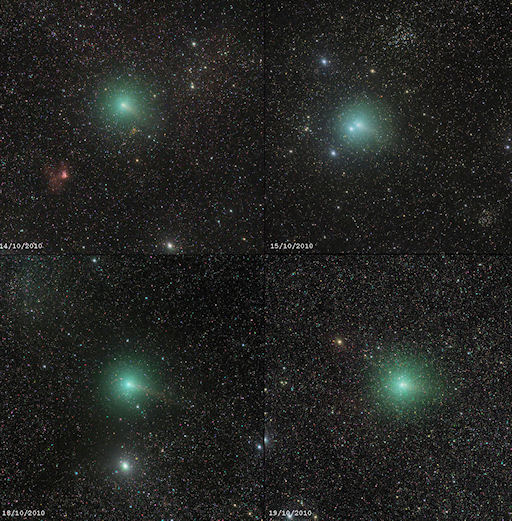JUPITER-MOON CONJUNCTION: Look east after sunset. Jupiter and the Moon are having a close encounter (< 6o) in the constellation Pisces. The bright conjunction is visible even from light-polluted urban areas, no sky map required.
Jupiter-Moon images: from Stefano De Rosa of Turin, Italy;
FILAMENT ERUPTION: For days, astronomers have been monitoring a "mega-filament" of magnetism splayed across the sun's southern hemisphere. Measuring more than 500,000 km from end to end, it spans a distance greater than the separation of Earth and the Moon. Oct. 18th the massive structure erupted:

Movie formats: 1.6 MB mpeg, 1 MB m4v. Credit: Solar Dynamics Observatory
Instabilities in the filament sparked a C2-class flare and hurled a portion of the filament's own magnetic backbone into space. The blast was not Earth-directed. Remarkably, the structure survived mostly intact and is still visible in backyard optics. Readers with solar telescopes are encouraged to monitor developments.
more images: from Paul Maxson of Surprise, Arizona; from Didier Favre of Brétigny sur Orge, France; from Jan Timmermans of Valkenswaard, The Netherlands; from Stephen W. Ramsden of Atlanta, GA; from Francesc Pruneda of Palamos, Girona, Spain;
TIME TO SEE COMET HARTLEY: For backyard stargazers, now is the best time to see green Comet 103P/Hartley 2 as it approaches Earth for an 11-million-mile close encounter on Oct. 20th. Set your alarm for the dark hours before dawn, go outside, and look straight up. You will find Hartley 2 not far from the bright star Capella: sky map. Although the comet is barely visible to the unaided eye, it is easy to find in binoculars and looks great through a backyard telescope.
Rolando Ligustri has been observing the comet nightly using a robotic 14-inch telescope in New Mexico. Click on the image to view the most recent week, including last night:

Many readers have asked, why is the comet green? Answer: Hartley 2's green color comes from the gases that make up its Jupiter-sized atmosphere. Jets spewing from the comet's nucleus contain cyanogen (CN: a poisonous gas found in many comets) and diatomic carbon (C2). Both substances glow green when illuminated by sunlight in the near-vacuum of space.
NASA scientists say 103P/Hartley 2 is one of the most active comets they've seen, with copious outgassing from jets in the nucleus. Amateur astronomers are encouraged to monitor the action and submit their images here.
more images: from Tom Jorgenson of Neenah, Wisconsin; from Yandong Hu of Mt. Wawushan, Jiangsu, China; from Rolando Ligustri using a robotic telescope in New Mexico; from Marian Urbaník of Staškov, Slovak republic; from John Chumack of Dayton, Ohio; from Jan Koeman of Kloetinge, the Netherlands; from Jodi and Roy McCullough of Salem Ohio; from Mike Broussard of Maurice, Louisiana; from Mike Holloway of Van Buren, Arkansas; from Norm Klekoda and Al Bell near Grand Rapids, MI; from Doug Zubenel of Monument Rocks, Gove County, Kansas; from Gregg Ruppel of Ellisville, Missouri
UPDATED: October 2010 Aurora Gallery
[previous Octobers: 2009, 2008, 2007, 2006, 2004, 2003, 2002, 2001]
Potentially Hazardous Asteroids (
PHAs) are space rocks larger than approximately 100m that can come closer to Earth than 0.05 AU. None of the known PHAs is on a collision course with our planet, although astronomers are finding
new ones all the time.
On October 19, 2010 there were 1155 potentially hazardous asteroids.
Notes: LD means "Lunar Distance." 1 LD = 384,401 km, the distance between Earth and the Moon. 1 LD also equals 0.00256 AU. MAG is the visual magnitude of the asteroid on the date of closest approach. | | The official U.S. government space weather bureau |
| | The first place to look for information about sundogs, pillars, rainbows and related phenomena. |
| | Researchers call it a "Hubble for the sun." SDO is the most advanced solar observatory ever. |
| | 3D views of the sun from NASA's Solar and Terrestrial Relations Observatory |
| | Realtime and archival images of the Sun from SOHO. |
| | from the NOAA Space Environment Center |
| | the underlying science of space weather |

